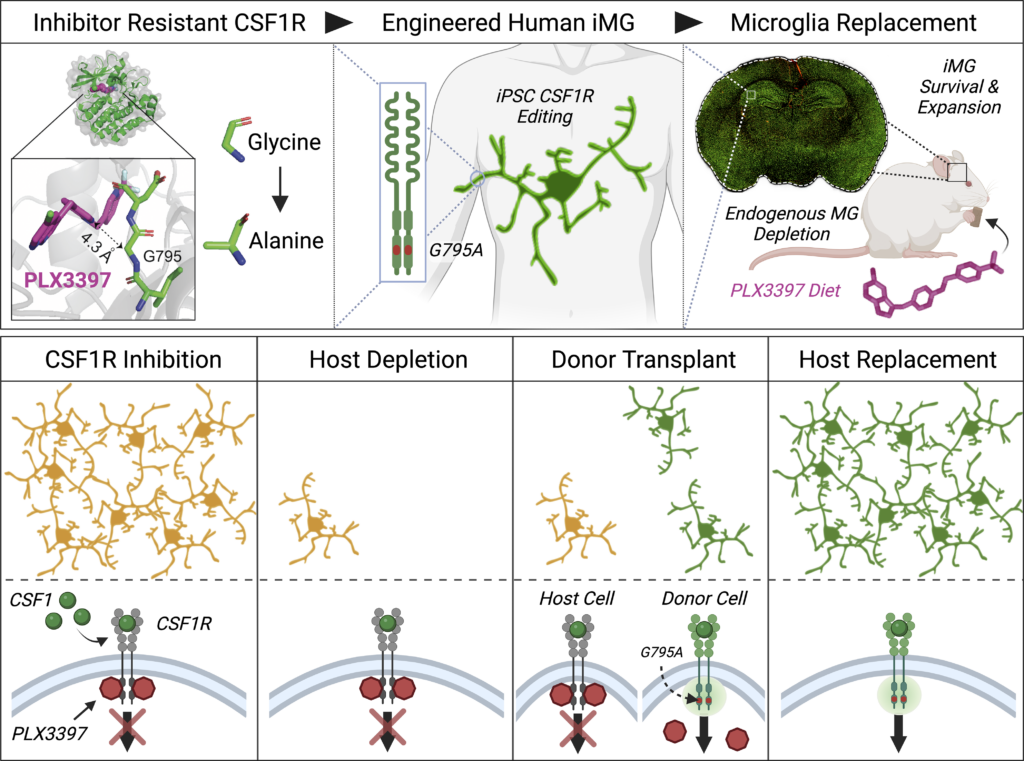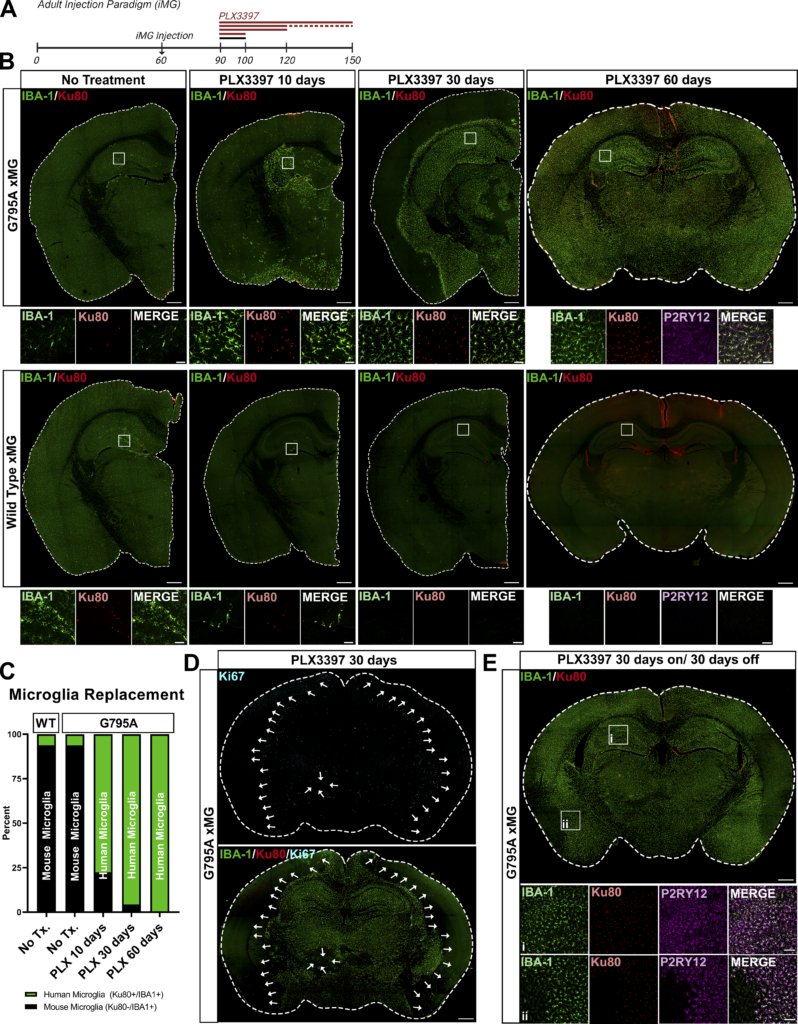J Exp Med. 2023 Mar 6;220(3):e20220857. doi: 10.1084/jem.20220857. Epub 2022 Dec 30.
Engineering an inhibitor-resistant human CSF1R variant for microglia replacement (ミクログリア置換のための阻害剤耐性ヒト CSF1R バリアントの設計)
Jean Paul Chadarevian # 1 2 3, Sonia I Lombroso # 4 5 6, Graham C Peet 4 7, Jonathan Hasselmann 1 3, Christina Tu 2 3, Dave E Marzan 8, Joia Capocchi 2, Freddy S Purnell 4, Kelsey M Nemec 4 9, Alina Lahian 2 3, Adrian Escobar 3, Whitney England 10, Sai Chaluvadi 4 9, Carleigh A O’Brien 4, Fazeela Yaqoob 4, William H Aisenberg 4, Matias Porras-Paniagua 11, Mariko L Bennett 9 12, Hayk Davtyan 2 3, Robert C Spitale 10, Mathew Blurton-Jones # 1 2 3, F Chris Bennett # 4 12
1Department of Neurobiology & Behavior, University of California, Irvine , Irvine, CA, USA.
2Institute for Memory Impairments and Neurological Disorders, University of California, Irvine , Irvine, CA, USA.
3Sue and Bill Gross Stem Cell Research Center, University of California, Irvine , Irvine, CA, USA.
4Department of Psychiatry, Perelman School of Medicine , University of Pennsylvania, Philadelphia, PA, USA.
5Pharmacology Graduate Group, Biomedical Graduate Studies Program, University of Pennsylvania , Philadelphia, PA, USA.
6Department of Systems Pharmacology and Translational Therapeutics, University of Pennsylvania , Philadelphia, PA, USA.
7Neuroscience Graduate Program and Department of Cell and Developmental Biology, University of Colorado Anschutz Medical Campus , Aurora, CO, USA.
8Department of Biology, The College of New Jersey , Ewing, NJ, USA.
9Department of Neuroscience, Perelman School of Medicine , Philadelphia, PA, USA.
10Department of Pharmaceutical Sciences, University of California, Irvine , Irvine, CA, USA.
11Department of Bioengineering, University of Pennsylvania , Philadelphia, PA, USA.
12Division of Neurology, Children’s Hospital of Philadelphia , Philadelphia, PA, USA.
カリフォルニア大学アーバイン校 (University of California Irvine)
Abstract
Hematopoietic stem cell transplantation (HSCT) can replace endogenous microglia with circulation-derived macrophages but has high mortality. To mitigate the risks of HSCT and expand the potential for microglia replacement, we engineered an inhibitor-resistant CSF1R that enables robust microglia replacement. A glycine to alanine substitution at position 795 of human CSF1R (G795A) confers resistance to multiple CSF1R inhibitors, including PLX3397 and PLX5622. Biochemical and cell-based assays show no discernable gain or loss of function. G795A- but not wildtype-CSF1R expressing macrophages efficiently engraft the brain of PLX3397-treated mice and persist after cessation of inhibitor treatment. To gauge translational potential, we CRISPR engineered human-induced pluripotent stem cell–derived microglia (iMG) to express G795A. Xenotransplantation studies demonstrate that G795A-iMG exhibit nearly identical gene expression to wildtype iMG, respond to inflammatory stimuli, and progressively expand in the presence of PLX3397, replacing endogenous microglia to fully occupy the brain. In sum, we engineered a human CSF1R variant that enables nontoxic, cell type, and tissue-specific replacement of microglia.
造血幹細胞移植(hematopoietic stem cell transplantation, HSCT)は、内在性のミクログリアを循環由来のマクロファージで置換することができるが、高い死亡率を伴う。造血幹細胞移植のリスクを軽減し、ミクログリア置換の可能性を広げるために、筆者らは、阻害剤耐性CSF1R(コロニー刺激因子1受容体)を作製し、強固なミクログリア置換を可能にした。ヒトCSF1Rの795位のグリシンからアラニンへの置換(G795A)は、PLX3397およびPLX5622を含む複数のCSF1R阻害剤に耐性を付与する。生化学的および細胞ベースのアッセイでは、識別可能な機能の増加または喪失は見られなかった。G795A-ではなく、野生型CSF1Rを発現するマクロファージは、PLX3397で治療したマウスの脳に効率よく生着し、阻害剤治療を停止しても持続した。さらに、ヒト多能性幹細胞由来のミクログリア(iMG)にG795Aを発現するようにCRISPR法を適用し、移植の可能性を検討したところ、ヒト多能性幹細胞由来のミクログリア(iMG)にG795Aを発現させることができた。異種移植試験により、G795A-iMGは野生型iMGとほぼ同一の遺伝子発現を示し、炎症刺激に応答し、PLX3397存在下で徐々に拡大し、内在性ミクログリアに代わって脳を完全に占拠することが実証された。つまり、我々は、無毒で、細胞種および組織特異的にミクログリアを置換することができるヒトCSF1Rバリアントを作製した。
Subjects:Neuroinflammation, Neuroscience

Conclusion
本論文では、CSF1Rのキナーゼポケット内のアミノ酸残基グリシンからアラニンへの変異がCSF1Riに対する耐性を高めるのに十分であること、CSF1Ri耐性マクロファージが内在性ミクログリアを枯渇させるのに十分な濃度の阻害剤の存在下でマウス脳内に効率よく生着できることを報告する。本研究は、G795Aの同定と検証を別々に行った2つのグループ(図1および図3)の研究を統合し、共同で発表したものである。前者はマウス細胞のウイルス導入によりヒトCSF1R変異の変数を実験的に分離し、後者はiPS細胞の内因性CSF1R遺伝子座をCRISPRエンジニアリングし、iMGによるミクログリア置換のトランスレーショナル・アプリケーションを検討した。その結果、G795AはCSF1Rシグナル伝達、炎症刺激に対する応答、ミクログリア遺伝子発現に明確な影響を及ぼさないことがわかった。しかし、今後の研究では、G795AがCSF1Rシグナル伝達、ドナー細胞の寿命、ミクログリア機能に対してどのような影響を及ぼすかを詳細に明らかにする必要がある。
以上のことから、今回の発見は、従来の化学療法や遺伝子組み換え宿主を用いずに、効率的にミクログリアを補充する新しい方法を提供するものであると期待される。最初の応用例としては、CSF1R関連白質脳症のようなミクログリア病の原因となる突然変異の修正、あるいはクラッベ病のような神経原性貯蔵障害におけるリソソーム加水分解酵素の欠如を補うためのデリバリーが考えられる(Bennett and Bennett, 2020)。この文脈では、CSF1Riの中止後もxMGの生着が安定しているという観察から、長期的な阻害剤治療はおそらく必要なく、安全性と特定の病態への最適化のために、ミクログリア置換の程度と速度を調節するように調整できる可能性があることが示唆される。さらに、細胞工学技術は急速に発展しているので(Finckら、2022)、近い将来、代謝、損傷反応、タンパク質凝集を調節するなどして、多くの脳疾患を治療するために、機構的情報に基づいたドナーマイクログリアの設計が可能になるだろうという仮説も立てている。
ミクログリア代替療法の他にも、この研究は、例えばイマチニブ耐性をもたらすような阻害剤耐性変異の同定が薬剤設計の中心である血液学や腫瘍学の分野にも応用できるかもしれない(Braun et al.、2020年)。G795Aの同定に適用したツールは、腫瘍学において腫瘍耐性変異を予測するために一般的に使用されているが、筆者らの知る限り、薬剤耐性受容体チロシンキナーゼ変異を細胞治療に応用したのは、今回が初めてである。筆者らは、このアプローチがキメラモデルにおけるミクログリア機能の研究を強化し、”生きた薬 “として人工組織常在マクロファージの送達を含む治療法への道を開くことを期待している。
*神経軸索スフェロイド形成を伴う遺伝性びまん性白質脳症(指定難病125)

Fig. 5. CSF1R inhibition enables the replacement of murine microglia with human G795A microglia in adult mice. (A) Schematic depicting timing of stereotactic iMG injection, PLX3397 treatment (red, 600 mg/kg chow) and endpoints at 90 (10 d of treatment or no treatment [black]), 120 d (30 d of treatment), 120 d (30 d on/30 d off treatment), and 150 d (60 d of treatment). (B) IBA1+ (green) and Ku80+ (red) G795A (top) and WT (bottom) human microglia exhibit limited engraftment within the adult murine brain without PLX3397 treatment (left). G795A microglia remain viable and progressively expand from the injection site across 10–60 (left-right) days of PLX3397 treatment while endogenous murine (Ku80−/IBA1+) and transplanted WT human microglia (bottom) are depleted by CSF1R inhibition. Brain stitch scale bar, 500 µm. Representative 40× scale bar, 50 µm. (C) Quantification of percent human (Ku80+/IBA1+) versus mouse (Ku80−/IBA1+) microglia reveal a progressive replacement of endogenous microglia, with 99% of microglia expressing the human nuclear marker Ku80 within 60 d. Counts calculated from three matched coronal sections per animal (n = 3 biological replicates per condition). (D) G795A microglia proliferate from the initial injection sites throughout the murine brain with a distinctive Ki67+ wavefront (blue, arrows). Scale bar, 100 µm. (E) G795A microglia persist in engrafted regions after cessation of 30 d PLX3397 treatment and immunostain for homeostatic microglia marker P2RY12 (purple). Brain stitch scale bar, 500 µm. Representative 20× scale bar, 100 µm.
